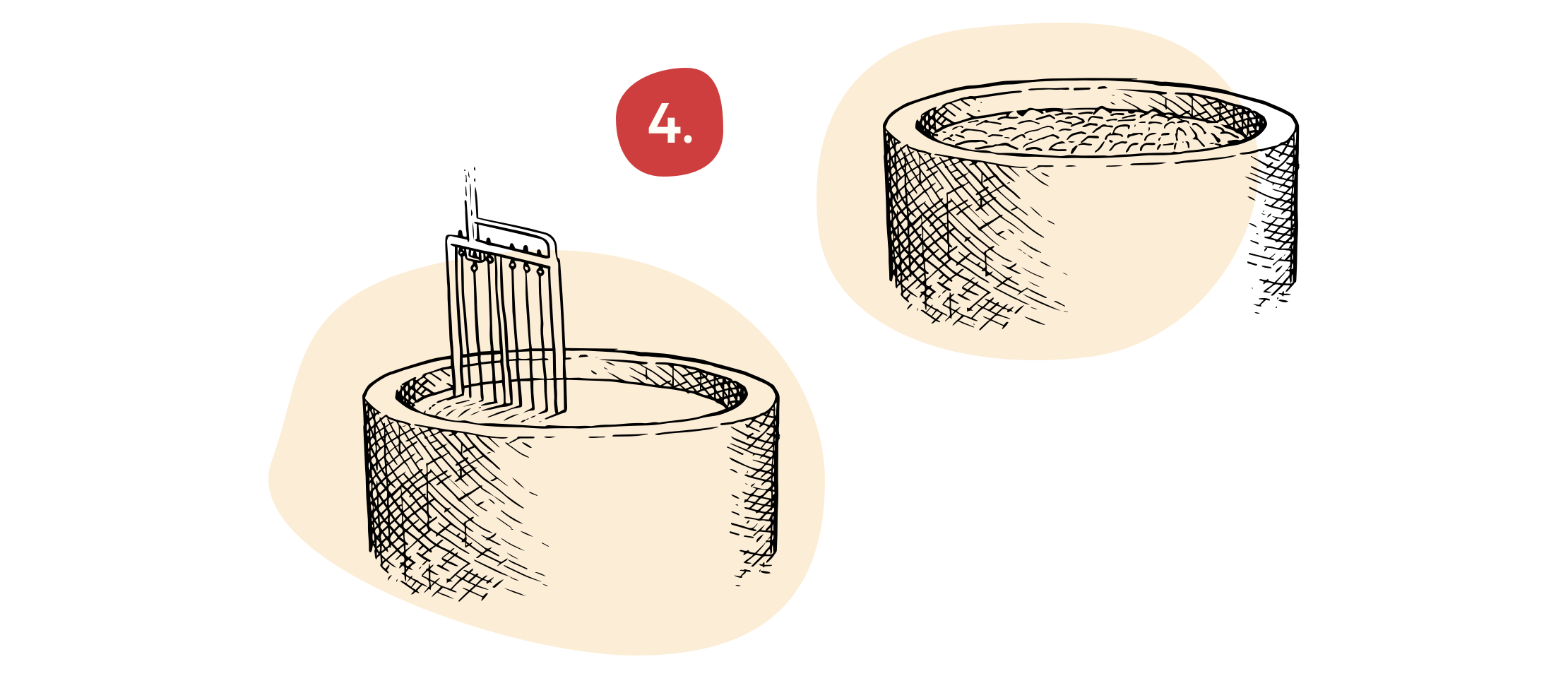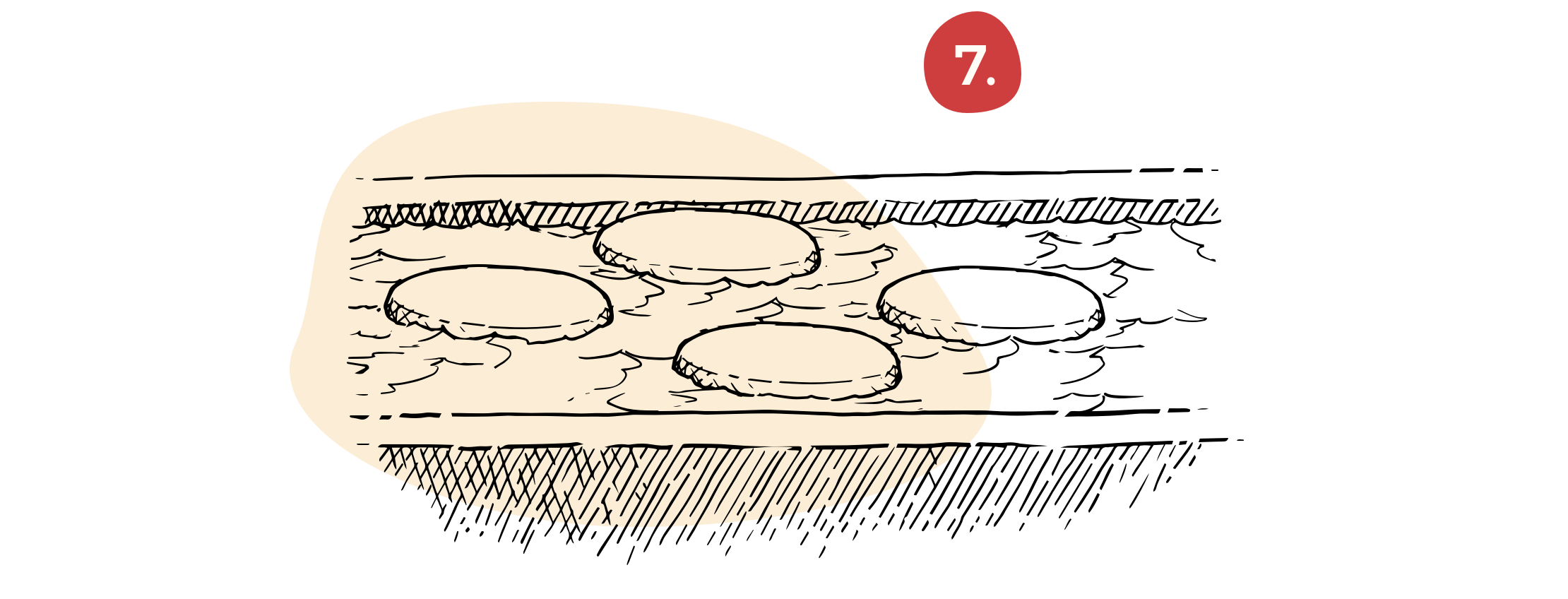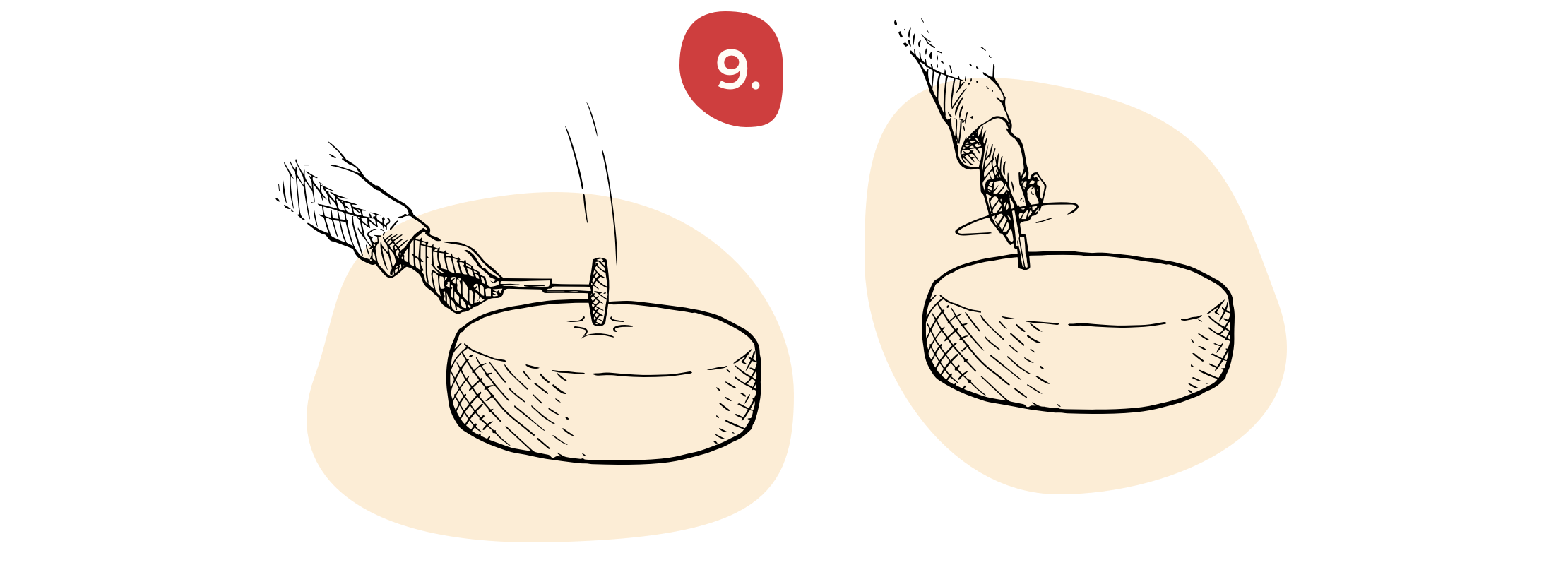Cheesemaking is a craft and one that requires plenty of expertise, along with great dexterity and precision. It is a craft in which many things are still done exactly as they were many centuries ago. Here we introduce you to the nine steps of cheesemaking and, in doing so, tell you a little bit about the history of Switzerland.
The basic ingredient: milk
Cheeses from Switzerland are produced from fresh milk, which is supplied by farmers to the creameries twice a day. The properties of this milk are partly responsible for the final character of the cheese.

There are over 700 varieties of Swiss cheese, but they all have one thing in common: their production starts with Swiss milk. The vast majority of the cheese is made using cow’s milk. Farmers tend to supply their creamery with fresh, low-germ milk from healthy animals twice each day. This single raw material is then used to produce a huge variety of different cheeses. There are so many different factors – including animal breed, feed, climate, milk fat content, different bacteria cultures, type of maturation and treatment – that lend each and every wheel of cheese its individual character.

Der findes over 700 varianter af schweizisk ost, men de har alle én ting til fælles: fremstillingen starter med schweizisk mælk. Langt størstedelen af ostene bliver lavet af komælk. Landmændene leverer som regel den friske mælk med lavt bakterieindhold fra sunde og raske dyr to gange om dagen. Denne ene råvare bruges derefter til at fremstille et stort udvalg af forskellige oste. Der er så mange forskellige faktorer – herunder kvægrace, foder, klima, mælkens fedtindhold, forskellige bakteriekulturer samt modningstype og behandling – der giver hvert eneste ostehjul sin individuelle karakter.

Milk selection and milk handling
Upon delivery, the milk is first tested for its quality and then filtered. Unpasteurised milk is tested rigorously – if no unpasteurised cheese is to be produced, the milk is gently thermised or pasteurised.

First, the milk is tested for its bacteriological and sensory condition. The following criteria are considered:
- The number of cells provides information about the udder health of the animals.
- The microbial count provides information about the hygiene of the milking and the milk.
- Inhibitors show whether the dairy cattle have been treated with antibiotics.
- The freezing point indicates the possibility of the milk having been diluted.
The creameries safeguard the production of unpasteurised milk through further tests specific to each creamery. Unless the milk is being used to produce genuine unpasteurised cheese, the milk is gently heated to produce thermised (warmed to 63°C) or pasteurised milk (warmed to at least 72°C).

Først bliver mælkens bakteriologiske tilstand testet, og der udføres en sensorisk analyse. Følgende kriterier tages i betragtning:
- Celleantallet giver information om, hvorvidt dyrene har sunde yvere.
- Det mikrobielle niveau giver information om hygiejnen i forbindelse med malkningen.
- Inhibitorer viser, hvorvidt malkekvæget er blevet behandlet med antibiotika.
- Frysepunktet angiver muligheden for, at mælken er blevet fortyndet.
Mejerierne sikrer produktionen af upasteuriseret mælk gennem yderligere testning, som varierer på de forskellige mejerier. Medmindre mælken skal bruges til at producere ægte upasteuriseret ost, bliver mælken nænsomt opvarmet for at opnå termiseret mælk (varmet til 63 °C) eller pasteuriseret mælk (varmet til mindst 72 °C).

Curdling the milk
The milk is poured into the vat and stirred as it is gradually heated. The lactic acid bacteria and rennet are then added to begin the coagulation process. This curdling results in a gelatinous substance.

The milk in the “cheese vat” is now gently heated up to 30°-32°C. The cheesemaker will then add special lactic acid bacteria cultures and the rennet. Adding the cultures increases the acidity in the milk, which increases the effect of the rennet. The milk is then left to stand for 35-40 minutes. Within this time, the rennet curdles the milk – the so-called curdling process. The cheese vat now contains curd: a smooth, pudding-like solid that awaits further processing.
In order to produce the famous AOP cheeses from Switzerland, bacteria are used that were naturally present in milk some 40 year ago and have since been cultivated by Agroscope Liebefeld-Posieux and can be sourced by the creameries from there as microbial strains.

Mælken i ostekarret opvarmes nu forsigtigt til 30-32 °C. Derefter tilsætter ostemageren særlige mælkesyrekulturer og osteløbe. Tilføjelsen af mælkesyrebakterier øger mælkens surhedsgrad, hvilket fremmer løbens effekt. Derefter får mælken lov til at stå i 35-40 minutter. Inden for dette tidsrum får osteløben mælken til at stivne – denne proces kaldes også koagulering. Ostekarret indeholder nu ostemasse: en glat, buddingagtig fast form, der er klar til videre behandling.
For at producere de berømte AOP-oste fra Schweiz anvendes der bakterier, som var naturligt til stede i mælk for omkring 40 år siden. Disse bakterier er siden er blevet kultiveret af Agroscope Liebefeld-Posieux, hvorfra mejerierne kan indkøbe dem som mikrobielle stammer.

Rennet can be sourced from the stomach lining of young calves (as well as young goats or lamb stomachs), from special bacteria cultures (microbial) or – rarely – from plants (for example, cardoon thistle or solanum dobium) and is used in liquid, powder or paste form. Genetically modified rennet is not used in Switzerland.
Just a few grams of rennet are all that is required to curdle around 1,000 litres of milk. But rennet does not just curdle the milk; it also helps the cheese to mature before it is eaten.
Løbe kan udvindes fra kalvemaver (samt fra lam og gedekid), fra særlige bakteriekulturer (mikrobiel) eller – sjældent – fra planter (for eksempel kardontidsel eller solanum dubium) og bruges i flydende form eller som pulver eller pasta. Genetisk modificeret løbe anvendes ikke i Schweiz.
Det kræver kun nogle få gram løbe for at koagulere cirka 1.000 liter mælk. Men løbe får ikke alene mælken til at koagulere; den hjælper også med at få osten til at modnes, før man spiser den.
Curd processing
Now the cheese harp is introduced: it is used to cut the curd into small pieces. These pieces of curd determine the type of cheese they will become – the smaller the pieces, the harder the final cheese will be.

As soon as the curd has reached the required consistency, it is cut with a cheese harp. A cheese harp may feature wires and/or blades, so that it can cut through the curd. The longer the cheese is stirred with the harp, the smaller the diameter of the small pieces of curd and the harder the final cheese will be. This is because the finer the curd, the less water there is in the cheese. This process varies for different types of cheese – as such, the cheesemaker must work with great precision here.

Så snart den stivnede ostemasse har nået den ønskede konsistens, bliver den skåret i små stykker (ostekorn) med en osteharpe. En osteharpe kan have metaltråde og/eller knive, så den kan skære igennem ostemassen. Jo længere tid ostekornene røres med harpen, desto mindre bliver de, og desto hårdere vil den færdige ost blive. Det skyldes, at mindre ostekorn betyder et lavere vandindhold i osten. Denne proces er forskellig, alt efter hvilken type ost der skal fremstilles, og ostemageren er derfor nødt til at arbejde med stor præcision.

Pre-curdling
The curds are stirred and heated up – the harder the cheese is to be, the higher the temperature. Thus, the cheese becomes increasingly solid.

The curds are now stirred and gradually heated. The higher the desired water content for the cheese, the more it is heated (hard and extra-hard cheese is heated to approx. 51-58 °C, soft cheese to approx. 35 °C). Stirring and warming the curds causes the curd granules to contract and separate from the whey. The cheese solidifies.

Ostekornene bliver nu gradvist opvarmet under omrøring. Jo lavere det ønskede vandindhold i osten, desto mere opvarmes den (hårde og ekstra hårde oste opvarmes til ca. 51-58 °C; bløde oste opvarmes til ca. 35 °C). Omrøring og opvarmning af ostekornene får dem til at trække sig sammen og afgive valle. Osten bliver fast.

Valle er faktisk er spildprodukt fra ostefremstillingen. Betegnelsen dækker over den tynde, grønlige væske, der løber fra, når ostemassen bliver fast. Vallen tappes fra og bliver derefter som regel centrifugeret og efterfølgende brugt til at lave andre produkter. Valleprodukter omfatter valledrikke, vallesmør og kvark. Den anvendes også i forarbejdede fødevarer samt i kosmetik i form af vallepulver. Dog bliver størstedelen af vallen brugt til dyrefoder.
Bemærk: "Molke", "Schotte"og "Sirte" er alle betegnelser for valle, der bruges i Schweiz – "Molke" er den mest almindelige betegnelse i de tysktalende lande.
Ostekornene bliver nu gradvist opvarmet under omrøring. Jo lavere det ønskede vandindhold i osten, desto mere opvarmes den (hårde og ekstra hårde oste opvarmes til ca. 51-58 °C; bløde oste opvarmes til ca. 35 °C). Omrøring og opvarmning af ostekornene får dem til at trække sig sammen og afgive valle. Osten bliver fast.

Whey is actually a waste product from the cheesemaking process – it is the name given to the green liquid, which escapes from the curd as it is processed. The whey is pumped away and generally spun and then processed into other products. Whey products include whey drinks, whey butter and quark. It is also used in processed foods or cosmetics as whey powder. However, the majority of the whey is used as animal feed.
Note: “Molke”, “Schotte” and “Sirte” are all names used for whey in Switzerland – “Molke” is the most common term in the German-speaking world.
Valle er faktisk er spildprodukt fra ostefremstillingen. Betegnelsen dækker over den tynde, grønlige væske, der løber fra, når ostemassen bliver fast. Vallen tappes fra og bliver derefter som regel centrifugeret og efterfølgende brugt til at lave andre produkter. Valleprodukter omfatter valledrikke, vallesmør og kvark. Den anvendes også i forarbejdede fødevarer samt i kosmetik i form af vallepulver. Dog bliver størstedelen af vallen brugt til dyrefoder.
Bemærk: "Molke", "Schotte"og "Sirte" er alle betegnelser for valle, der bruges i Schweiz – "Molke" er den mest almindelige betegnelse i de tysktalende lande.
Shaping and pressing
Once the desired solidity level has been reached, the cheese is poured into a mould. The holes in the base of the mould allow the whey to escape. In addition, the entire cheese is compressed to remove additional liquid.

As soon as the cheese has the right level of solidity, it is filled into perforated moulds together with the whey. The whey now drains off and the cheese mass remains in the mould. Cheese brands are applied straight away as a “cheese passport” for identification purposes. The lid of the mould is placed over the cheese and the cheese is compressed. This lends the cheese the desired shape and also helps to remove additional whey.

Så snart osten har den ønskede fasthed, hældes den i perforerede forme sammen med vallen. Vallen løber nu fra, og ostemassen bliver i formen. Ostemærket påføres med det samme som et "ostepas" til identifikationsformål. Der lægges låg oven på osten i formen, og osten presses sammen. Det giver osten den ønskede form og hjælper også med at fjerne overskydende valle.

Brine bath
The brine bath is the next step: the floating cheese absorbs the salt and releases whey. The rind forms gradually and the flavour of the cheese becomes more intense.

Depending on the size of the cheese, it can be placed in a bath of brine for between a few hours and two days. The brine bath has a salt content of around 22% and a temperature of approx. 15 °C. The high salt content helps to remove more of the whey and the cheese also absorbs the salt. During this process, the cheese solidifies and a rind forms on the surface. This gives the cheese the protection it requires from external influences and helps to keep the shape of the cheese. The brine bath also prevents the formation of undesired bacteria on the surface. The absorption of the salt improves the taste of the cheese.
Interesting fact: the density of the brine of 1.15 kg / l means that the heavy wheels of cheese actually float in the brine bath.

Afhængig af ostens størrelse kan den ligge i saltlage i alt fra nogle få timer til to dage. Lagen har et saltindhold på omkring 22 % og en temperatur på ca. 15 °C. Det høje saltindhold hjælper med at fjerne mere af vallen, og osten absorberer også saltet. Under denne proces bliver osten fast, og der dannes en skorpe på overfladen. Det giver osten den nødvendige beskyttelse mod påvirkninger udefra og hjælper den med at holde formen. Saltlagen modvirker også, at der opstår uønskede bakterier på overfladen. Absorberingen af salt forbedrer ostens smag.
Et interessant faktum: Saltlagen har en densitet på 1,15 kg pr. liter, hvilket betyder, at de tunge ostehjul faktisk flyder i saltlagen.

Maturation and affinage
The cheese undergoes several changes during maturation in the cellar: the rind develops, the inside of the cheese changes colour, holes are formed and the cheese solidifies. An affineur often refines the cheese by rubbing in herbs, cider or white wine.

The process continues in the cellar. Cheese maturation covers the entirety of the enzyme processes that take place in cheese. A rather tasteless, fresh protein is transformed into a soft, delicious cheese, bursting with character.
Cheese maturation leads to visual, chemical and microbiological changes in the cheese:
- the visual signs include the formation of an external rind, holes inside the cheese ((infobox)), a smooth cheese and changes in colour.
- Bio-chemical processes break down the protein into amino acids and lead to a change in the state of the cheese, making it easier to digest.
- Both microbiological influences and varying production methods can affect the formation of holes.
Maturation spans from a few days to several months or even years. During this time, the cheese turns into a solid. The maturation period depends on the variety and the size of the cheese, and is defined in product specifications and market regulations.
Cheese maturation is also known as affinage. An affineur adds the finishing touches to the cheese during maturation and only presents the cheese for sale when it has reached peak maturation. Special expertise is required to calculate this moment. The flavour of a cheese can also be enhanced through additional treatments with cider, white wine, special herbal brine etc. during this stage.

Processen fortsætter i kælderen. Ostemodningen dækker hele enzymprocessen, som finder sted i osten. Et forholdsvis smagløst, frisk protein forvandles til en blød, lækker ost fyldt med karakter.
- Modningen medfører visuelle, kemiske og mikrobiologiske ændringer i osten:
- De visuelle tegn omfatter dannelse af den udvendige skorpe, huller inden i osten ((infoboks)), en ensartet konsistens og ændringer i farven.
- Biokemiske processer nedbryder proteinet til aminosyrer og medfører en forandring i osten, som gør den nemmere at fordøje.
- Både mikrobiologiske indvirkninger og forskellige fremstillingsmetoder kan påvirke dannelsen af huller.
Modningen kan strække sig over nogle få dage op til adskillige måneder eller endda år. I løbet af denne tid bliver osten fast. Modningstiden afhænger af varianten og ostens størrelse og er fastlagt i produktspecifikationer og markedsreguleringer.
Modningen af osten kaldes også affinage. En affineur lægger sidste hånd på værket under modningen af osten og lader først osten komme i handelen, når den er modnet optimalt. Det kræver specialiseret ekspertise at beregne det nøjagtige tidspunkt. Ostens smag kan også forbedres på dette stadie gennem yderligere behandlinger med cider, hvidvin, særlige urtelager osv.

A popular topic and an issue that sparks all kinds of speculation: what are the holes in the cheese all about?
Gas-forming microorganisms create carbon dioxide, or CO2. In solid or viscous cheese, the CO2 cannot escape evenly and slowly out of the cheese. As a result, large, irregular holes are formed or cracks created in the places where there is a heavy concentration of gas.
The CO2 is distributed evenly in soft cheese. This means that a large, even hole can “grow” gradually in places where the curds have not grown together. CO2 creates good holes due to its high water solubility.
Et voilà! The mystery behind the holes in the cheese has been solved!
Et populært emne og et spørgsmål, der er genstand for megen spekulation: Hvorfor er der huller i osten?
Mikroorganismer i osten laver kuldioxid (CO2). I fast eller tyktflydende ost kan kuldioxiden ikke stille og roligt slippe ud af osten. Derfor opstår der store, uregelmæssige huller eller revner på de steder, hvor der er en større koncentration af gas.
Kuldioxiden fordeler sig jævnt i blød ost. Det betyder, at der gradvist kan vokse et stort hul med en ensartet form frem på steder, hvor ostekornene ikke er vokset sammen. CO2 laver gode huller på grund af dens høje vandopløselighed.
Voila! Mysteriet om hullerne i osten er løst!
Quality control
The final step sees the cheese undergo various tests. They include inspections of the hole formation, the cheese quality, the taste and the external appearance. Then the cheese is ready to be sold.

Before the cheese is sold, it undergoes thorough testing. This ensures that only excellent quality cheese is sold. The formation of holes, the quality of the cheese, the taste and the external appearance (shape and preservation) are all inspected and assessed.

Før osten bliver solgt, bliver den omhyggeligt testet. Det sikrer, at der kun sælges ost af fremragende kvalitet. Dannelsen af huller, ostens kvalitet og smag samt det udvendige udseende (form og præservering) bliver inspiceret og bedømt.

Before the cheese is sold, it undergoes thorough testing. This ensures that only excellent quality cheese is sold. The formation of holes, the quality of the cheese, the taste and the external appearance (shape and preservation) are all inspected and assessed.

